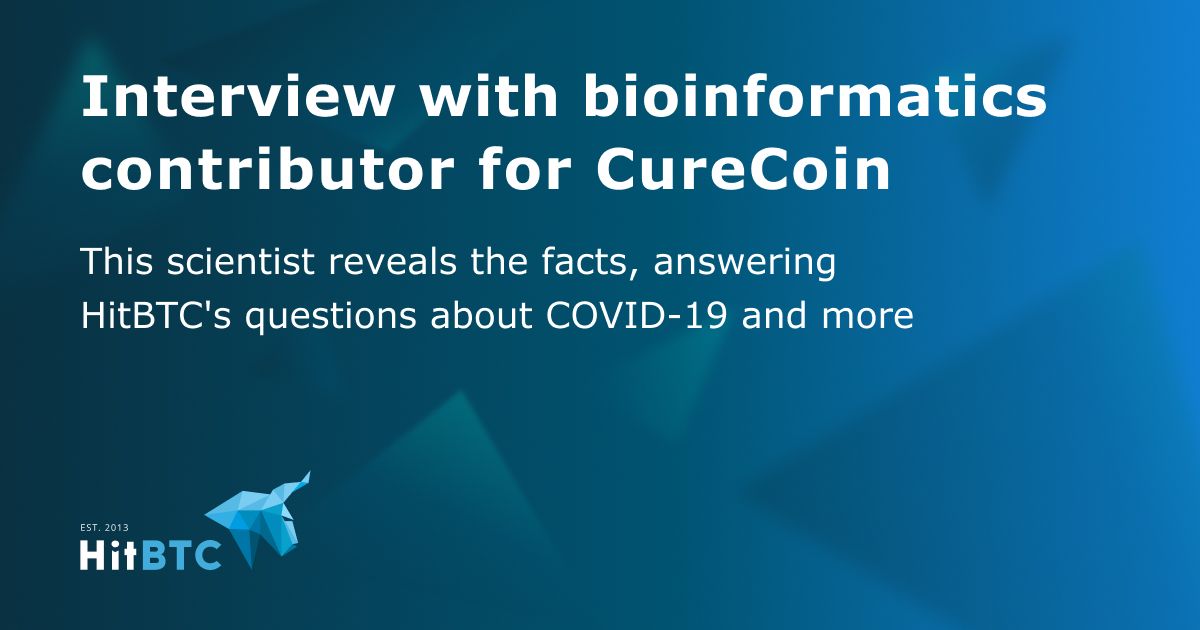Interview with bioinformatics contributor for CureCoin, newest project in the HitBTC ecosystem


Back at the end of March we announced the start of our COVID-19 initiative, which we launched in order to help projects looking to join in the fight against the global coronavirus pandemic. We are happy to share that we were able to interview Josh Smith from CureCoin, the first project we have integrated as part of the initiative, along with a contributing scientist and bioinformatics guru working hands on with the data at the heart of the project. The first interview we will release will be with the bioinformatics and data analyst, who will remain unnamed due to ongoing restrictions applied to the scientists partaking in this research.
CureCoin got started in 2014 as part of the Folding@home project. Folding@home is an initiative backed by Stanford University that has been using a distributed computer network to collate computing power in order to study how proteins misfold themselves. Protein misfolding is a process that occurs over time in the human body due to mutations and other changes and leads to a variety of degenerative diseases.
With everything that has been happening due to the ongoing coronavirus pandemic, Folding@home has prioritized research related to COVID-19 in order to help better understand the disease and thereby come up with a cure.
HitBTC: How are proteinopathies similar between cancer, Alzheimer’s, Huntingtons and infectious diseases – how can only a few pieces of software (GROMACS, OpenMM, etc) cover such a broad range of diseases?
Contributing Scientist: Well, for sure, all diseases can vary in strains and mutations, what we know is based on current health data of individuals suffering from those diseases. There are other diseases that could cause cancer and other infectious diseases in the long term as one individual hits a certain age. Unfortunately, many disease causes rely on unknowns on whether someone inherited it, or whether it was caused by other diseases, etc. To interpret all these causes, yes in-silico modeling can provide us with certain answers to start developing therapeutics and be able to make them safe. Cells receptors and protein binding is what we are interested in the most; on whether a cancerous cell can be killed by entering through its receptors and hitting its nucleus destroying that cell, or keeping our immune cells safe by developing blockers to deactivate foreign cells to prevent killing our cells like the T-Cells, B-Cells … (immune cells) that fight for us to kill those foreign cells. Most drug bindings are emphasized to create or design blockers or inhibitors to protect our immune cells [and let them do their job]. The study of immune cells in a silico modelling is another part of informatics that helps us understand their behaviour and molecular structure when cells enter into a stressful situation.
H: How do you foresee the huge potential in combating debilitating disorders using distributed supercomputing compared to dedicated supercomputers? (cost, availability during time sharing, etc)
CS: Well yes it’s essential to utilize all the tools necessary to understand a disease, and be able to take it to the lab running experiments that will cut cost and time since using lab equipment, reagents etc are super expensive to maintain and use.
H: Folding@home is now considered to be one of the world’s most widely distributed and fastest computing systems with a speed of approximately 1.18 exaFLOPS, or 2.36 x86 exaFLOPS, allowing it to fold several proteins in the 1.5 millisecond time range. How does this compare to experimental crystallography methods of the past?
CS: This part is more for a chemist or biochemist that is using “experimental crystallography methods”. [From my experience] when developing a certain molecule, we use radiation to break bonds and to determine potency we used radioactive Iodine-125 bioassays and similar compounds – so YES having a computer modelling allows us to see the molecules folding and predict how to target those receptors better [without the need for costly, often inaccurate chemical experiments early on].
H: What is a k-factor in protein folding dynamics and molecular simulations – the factor that is used in determining Points awarded to protein folders on Folding@home?
CS: K-factor is part of what determines the PPD point value of a Folding@home Work Unit (WU). Based on Folding@home’s description, many factors go into determining a WU’s value. The kinematic and thermodynamics variables that induce difficulty in protein folding, and the scientific value resulting from a successful simulation of that molecule’s structure. Traditionally, chemists have done this all day. Dangerously! Bravo to them, and bravo for them risking their lives in those research labs! That’s one of the biggest value-adds to research in-silico simulations. [The Urey-Miller Ab initio nanoreactor experiment perhaps shows this most clearly (see also Carl Sagan on Cosmos). In 1952, scientists basically tried to create life in a jar, simulating conditions (through many permutations) that were found on earth before life arose. They were able to find some organic compounds, but the experiment was limited by equipment funding and dedicated lab time. In 2014, Folding@home was able to take the same experiment, and run it virtually on Folding@home software through thousands of permutations. They were able to find 600 unique organic compounds never seen on earth today – similar to the compounds we are just beginning to uncover hidden deep inside meteorites. It’s not “life” as we know it, but it represents life’s fundamental building blocks].
H: What novel methods do Folding@home researchers utilize to statistically analyse the dynamics of protein folding? AI is used to both generate the initial folding model, AND to analyse all the data generated by the protein folders. Why are Markov state models the preferred method for analyzing protein models?
CS: Yes, in-silico modeling is what everyone looks at first [in the FDA drug approval process] – which is essential these days. Markov modelling provides a robust understanding of specific clusters that are grouped in certain strains, mutations, or any specific characteristic that could be unknown. Markvov works well by giving a great amount of data already from that specific mRNA, cell type, receptors (e.g., ion channels), or other to classify each one as one group based on certain characteristics or variables as an identifier… depending on what you are trying to accomplish obviously, the algorithms can be tailored to characterize each given molecule.
H: As the available computational power now exceeds 1 exaflop — faster than some of the world’s top supercomputers — what kind of exploration can be done at this level? Can you explore Ion channels, protein folding time scales, etc?
CS: As more computational power we have available through distributed computing, the more “super complex systems” (like ion channels) can be explored in ways not possible less than a decade ago. Understandably, humans have the most studied, yet most complex metabolisms, and immune systems. Thus to fight diseases requires an extraordinary amount of computational power. [Even with all the available power, we are decades away from being able to fully simulate entire organs, let alone an entire human being].
H: How does the COVID-19 research compare with the Ebola virus epidemic in 2013-2016? Could you discuss the different types of viruses (positive-strand vs negative-strand RNA) and their means of transmission?
CS: These diseases are neither the same in how they are transmitted nor in the RNA they contain (a coronavirus is a single-stranded, positive-sense RNA virus, while Ebola is a single-stranded negative-sense RNA virus, so how they bind inside our cells is different). Coronavirus is a respiratory disease that can be transmitted merely through breathing the same air in close proximity of an asymptomatic patient, Ebola is a hemorrhagic fever transmitted only through contact with bodily fluids of patients who are visibly ill.
While CureCoin is the first project we have integrated via our initiative, we hope to add more projects that are trying to make a meaningful impact in the fight against the virus. In the meantime, we hope you find the interviews informative.
